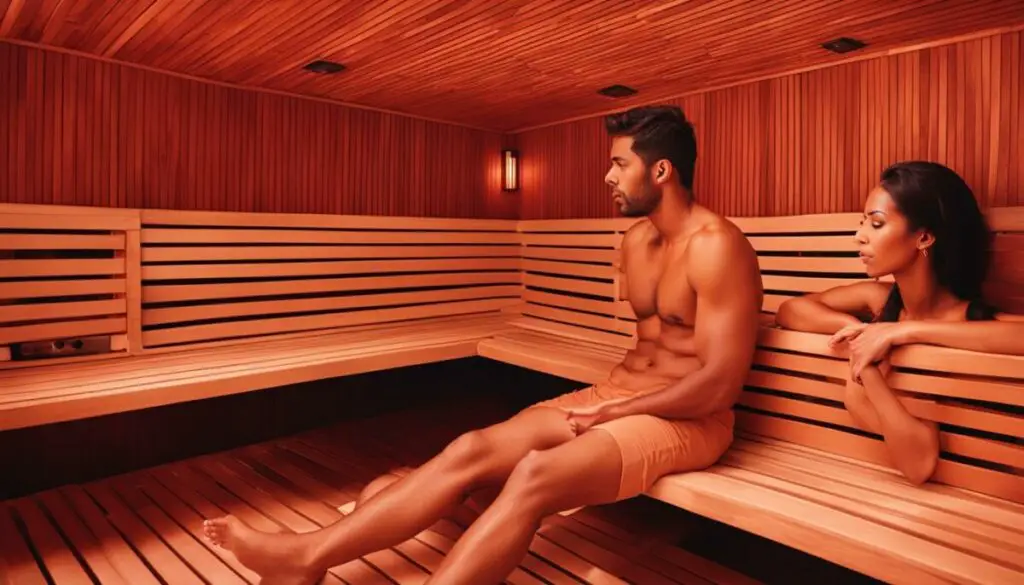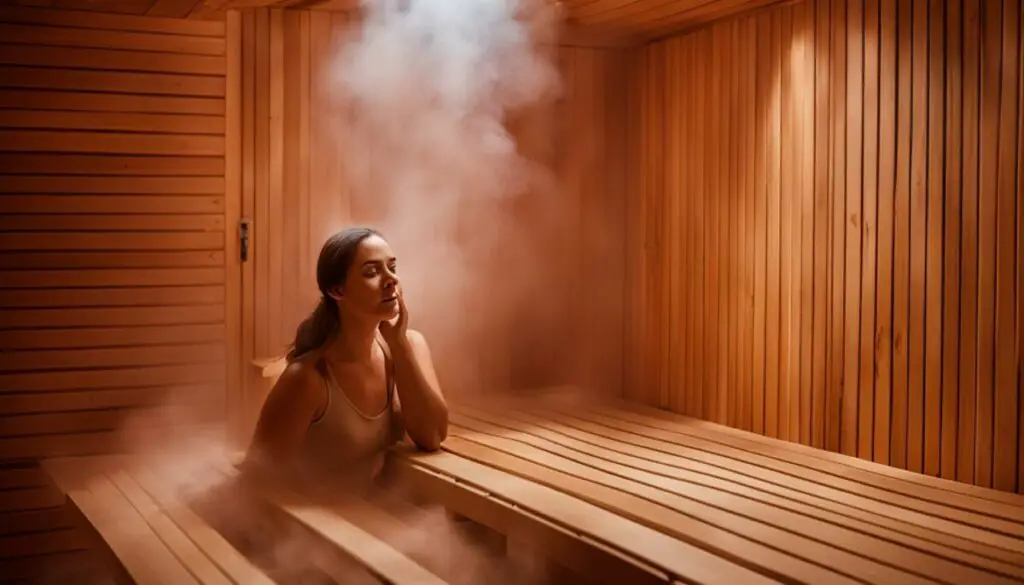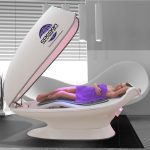Last Updated on 5 months by Francis
If you’ve recently tried an infrared sauna and found yourself lacking in sweat, don’t worry; you’re not alone. Infrared saunas are designed to induce sweating, but sometimes, this process can be delayed or even nonexistent. There are several factors that can contribute to this issue, which we will discuss in detail in the upcoming sections.
It’s important to understand the relationship between infrared saunas and sweating to troubleshoot this problem effectively. Sweating is a natural response of the body to regulate temperature and eliminate toxins, and infrared saunas use infrared light to generate heat, which penetrates the body to induce sweating.
In the following sections, we will delve into the potential factors that can influence sweating in an infrared sauna, such as inadequate hydration, body composition, medications, and underlying health conditions. By understanding and addressing these factors, you can optimize your sauna sessions and achieve a satisfying sweat experience.
Contents
Key Takeaways:
- Not sweating in an infrared sauna is a common issue that can be caused by various factors
- Sweating is a natural response of the body to regulate temperature and eliminate toxins
- Infrared saunas use infrared light to generate heat, which penetrates the body to induce sweating
- Potential factors that can influence sweating in an infrared sauna include inadequate hydration, body composition, medications, and underlying health conditions
- By addressing these factors, individuals can optimize their sauna sessions and achieve the full benefits of sweating
Understanding Infrared Saunas and Sweating

Before exploring the reasons behind a lack of sweat in an infrared sauna, it’s essential to understand the science behind sweating in this type of sauna. Infrared saunas work by emitting infrared light, which penetrates deep into the body’s tissues. This penetration causes the body to heat up from the inside out, stimulating sweat production as a natural cooling response.
However, the absence of sweating in an infrared sauna isn’t always because of a malfunctioning unit or system. It could be due to several other reasons.
One reason could be the concept of sweat rate. Sweat rate refers to the amount of sweat an individual produces, and it varies from person to person. Some people may sweat excessively, while others may not sweat as much. Moreover, sweat production can change based on factors like weather, hydration levels, and physical activity levels.
Another reason could be the type of sweat produced. Sweat comprises water, salt, and other minerals. Infrared saunas generate heat that causes the body to produce sweat that’s primarily composed of water and minerals. Compared to traditional saunas that generate heat from the outside in, infrared saunas’ deep tissue penetration results in lower sweat rates, producing sweat that’s more watery in nature than the thicker sweat generated in traditional saunas.
It’s essential to understand that sweating is a natural body function that varies in degree and frequency. While sweating in an infrared sauna is often a desirable outcome, it’s important to not stress too much about lack of perspiration. The benefits of infrared saunas extend beyond just sweating, including pain relief, relaxation, and detoxification.
Potential Factors Influencing Sweating in Infrared Saunas

While infrared saunas are generally effective at inducing sweating, some individuals may experience sweating issues in infrared sauna. In this section, we will explore the possible reasons for not sweating in an infrared sauna.
Individual Differences in Body Composition
One possible reason behind a lack of sweat in infrared saunas could be individual differences in body composition. Individuals with higher body fat percentages may experience reduced sweating compared to those with lower body fat percentages. This is because adipose tissue acts as insulation, preventing heat from penetrating the body and inducing sweating.
In contrast, individuals with lower body fat percentages may experience more sweating due to a greater surface area-to-volume ratio, which allows for more efficient heat transfer.
To maximize sweat production in infrared saunas, individuals with higher body fat percentages should aim to increase their metabolic rate through regular exercise and dietary modifications. This can help to reduce body fat and improve overall sweating patterns.
Hydration Levels
Another reason for not sweating in an infrared sauna could be inadequate hydration levels. When the body is dehydrated, it may struggle to produce sweat effectively, leading to reduced sweating or no perspiration in infrared sauna.
To encourage sweating, individuals should aim to drink water before and during sauna sessions. Aim to consume at least 8 ounces of water prior to entering an infrared sauna and continue to sip water as needed throughout the session to maintain hydration levels.
Overall Health and Medications Usage
Individuals with underlying health conditions, such as hypothyroidism or autonomic dysfunction, may experience abnormal sweating patterns. Additionally, certain medications, such as antihistamines and antidepressants, can interfere with the body’s ability to sweat, leading to no sweat in infrared sauna.
Individuals with pre-existing health conditions or those taking medications regularly should consult with their healthcare provider before using an infrared sauna. They may suggest modifications or offer guidance to optimize sweating during sauna sessions.
Personal Tolerance to Heat
Finally, personal tolerance to heat may also affect sweating patterns in infrared saunas. Individuals who are new to infrared sauna sessions or those who have a lower heat tolerance may not sweat as much initially.
To increase sweat production in infrared saunas, individuals should gradually acclimate themselves to the heat by starting with lower temperatures and shorter session durations. Over time, the body will adapt to the heat, leading to increased sweating and greater heat tolerance.
Understanding the potential factors influencing sweating in infrared saunas can help individuals troubleshoot and overcome sweating issues in infrared sauna. By addressing individual differences in body composition, ensuring adequate hydration, addressing underlying health conditions or medications, and gradually acclimating to the heat, individuals can optimize their infrared sauna sessions and achieve a satisfying sweat experience.
Hydration and Sweating

One potential solution to a lack of sweat in the infrared sauna is to ensure adequate hydration. When the body is dehydrated, it may struggle to produce sweat effectively, leading to reduced sweating or no sweating at all. To maximize sweating in the infrared sauna, it is essential to stay hydrated before and during the sauna session.
A good way to gauge hydration levels is to monitor urine color. Clear or light yellow urine indicates adequate hydration, while dark yellow urine suggests dehydration. Before getting into the infrared sauna, drink plenty of water or electrolyte-rich fluids like coconut water or sports drinks to ensure proper hydration.
| Hydration Tips: | Why it Helps: |
|---|---|
| Drink water prior to sauna sessions | Ensures adequate hydration, improves sweating |
| Bring a water bottle into the sauna and sip during the session | Helps maintain hydration levels, encourages sweating |
| Monitor urine color | Aids in identifying hydration status |
| Avoid alcohol and caffeine before sauna use | Both can dehydrate the body and hinder sweating |
By staying hydrated, you can increase your chances of producing sweat and getting the most out of your infrared sauna session. Remember to drink water before, during, and after each session to support healthy sweating and avoid dehydration.
Body Composition and Sweating

Another factor that can influence sweating in an infrared sauna is body composition. As per a study conducted by the American Council on Exercise, the body fat percentage can impact sweat production. Individuals with higher body fat percentages may experience reduced sweating compared to those with lower body fat percentages.
The reason behind this is that adipose tissue acts as a barrier, making it difficult for infrared light to penetrate the skin and heat the body. This can result in the production of less sweat, making it difficult for individuals with higher body fat percentages to benefit fully from their infrared sauna sessions.
However, individuals with higher body fat percentages need not worry about missing out on the benefits of sweating. There are ways to maximize sweat production even with higher body fat percentages. One such way is to increase the duration of the sauna session. For instance, if you typically have a session of 20 minutes, try to increase it to 30 minutes or more gradually.
- Adjusting the temperature is another effective technique to maximize sweat production.
- Wearing loose clothing and avoid wearing tight clothes and heavy jewelry that can inhibit sweat production.
- Drinking enough water before and after the sauna sessions can help to increase sweat production.
- Including breathing exercises during the session can also stimulate sweating. Inhale for four counts through your nose and exhale forcefully for four counts through your mouth. This technique helps to increase circulation and generate more sweat.
By following these tips, individuals with higher body fat percentages can experience more significant benefits from their infrared sauna sessions.
Common Medications and Sweating

If you’re taking any medications regularly, it might be the reason behind your lack of sweating in the infrared sauna. Certain medications, such as antihistamines and antidepressants, can interfere with the body’s ability to sweat. This can lead to a reduced amount of sweat production, which can be frustrating when you’re trying to get the most out of your infrared sauna session.
Antihistamines, often taken to combat allergies, work by blocking histamine, which is a natural substance that contributes to the production of sweat. As a result, antihistamines can reduce sweating and make it difficult for your body to expel toxins.
Similarly, certain types of antidepressants, such as tricyclic antidepressants and selective serotonin reuptake inhibitors (SSRIs), can also interfere with sweating. These medications affect the function of the sympathetic nervous system, which controls functions like sweating and heart rate.
If you suspect that your lack of sweating in the infrared sauna is due to medication use, it’s important to speak with your doctor about potential alternatives. In some cases, they may be able to prescribe a different medication that won’t interfere with your body’s ability to sweat. Alternatively, they may be able to recommend strategies to help you manage sweating while on your current medication.
“Certain medications, such as antihistamines and antidepressants, can interfere with the body’s ability to sweat.”
If changing your medication isn’t an option, there are still things you can do to maximize sweat production during your infrared sauna session. Drinking plenty of water before and during your session can help ensure that you’re adequately hydrated. Additionally, adjusting the temperature settings or increasing session duration may encourage your body to start sweating.
It’s important to remember that every individual’s body is different, and what works for one person may not work for another. If you’re struggling with sweating in the infrared sauna, be patient and keep experimenting until you find a solution that works for you.
Health Conditions and Sweating

If you have an underlying health condition, such as hypothyroidism or autonomic dysfunction, it might be the culprit behind your lack of sweat in an infrared sauna. These conditions can affect the body’s ability to regulate temperature and sweat effectively. For instance, hypothyroidism can cause a decrease in sweat production due to reduced metabolic activity. Autonomic dysfunction, on the other hand, can disrupt the signals between the brain and sweat glands.
It’s essential to consult with your healthcare provider before using an infrared sauna if you have a health condition that affects your sweating patterns. Your doctor can provide valuable guidance on how to safely and effectively use an infrared sauna.
If you have an underlying health condition, consult with your healthcare provider before using an infrared sauna.
Managing Health Conditions in Infrared Saunas
If you have a health condition that affects your sweating patterns, there are several strategies you can implement to optimize sweating in infrared saunas. For example:
- Consult with your doctor before sauna use: If you have a health condition, it’s essential to discuss infrared sauna use with your healthcare provider. They can provide personalized recommendations based on your specific medical history and condition.
- Stay within your comfort zone: Individuals with health conditions may have lower heat tolerance levels. It’s crucial to gradually increase the temperature and duration of your sauna sessions to avoid any adverse reactions.
- Monitor your vital signs: It’s essential to monitor your heart rate, blood pressure, and body temperature during sauna sessions. Individuals with specific health conditions, such as cardiovascular disease, may need to limit the intensity and frequency of their sauna sessions.
- Stay adequately hydrated: Proper hydration is essential before and during infrared sauna use, especially if you have a health condition. Adequate hydration can help regulate body temperature and support sweat production.
By implementing these strategies and following your doctor’s recommendations, you can safely and effectively use an infrared sauna, even if you have an underlying health condition affecting your sweating patterns.
Tips to Maximize Sweat Production in Infrared Saunas
If you’re struggling to sweat in your infrared sauna, try these tips to enhance your sweat experience:
- Adjust the temperature: Make sure the temperature is high enough to induce sweating. A temperature range between 110-130°F is ideal for most individuals.
- Increase session duration: Longer sessions can help increase sweat production. Start with shorter sessions and gradually increase the duration.
- Hydrate before and during sessions: Dehydration can inhibit sweating. Drink plenty of water before and during your sauna session.
- Use heat-boosting accessories: Accessories like sauna hats and towels can help trap heat and increase sweating.
- Breathe deeply: Deep breathing exercises can help increase circulation and promote sweating.
| DO | DON’T |
|---|---|
| Adjust the temperature to a comfortable level and gradually increase it once you are used to it. | Stay in the sauna for too long. Listen to your body and take breaks if necessary. |
| Use heat-boosting accessories to enhance your sweat experience. | Use the sauna if you have a medical condition that contraindicates sauna use. Always check with your doctor first. |
| Drink plenty of water before and during your sauna session to stay hydrated. | Consume alcohol before or during your sauna session as it can lead to dehydration. |
By implementing these tips, you can increase your sweat production and optimize your infrared sauna experience. Remember to always listen to your body and take breaks if necessary to avoid overheating.
Conclusion
As we have explored in this article, a lack of sweating in an infrared sauna can be frustrating, but it doesn’t have to be a permanent issue. By understanding the relationship between infrared saunas and sweating and addressing potential factors that can affect sweating, individuals can optimize their sauna sessions and maximize the benefits of sweating.
Key Takeaways
- Hydration is crucial for effective sweating in an infrared sauna. Drink plenty of fluids before and during your session.
- Body composition can affect sweat production. Consider incorporating cardiovascular exercise into your routine to increase your body’s ability to sweat.
- Common medications and underlying health conditions can affect sweating patterns. Consult your healthcare provider if you suspect this is the case for you.
- Experiment with different temperature settings, session durations, and heat-boosting accessories to optimize your sauna experience.
Remember, sweating in an infrared sauna is a natural process that can help eliminate toxins and improve overall health. By troubleshooting any issues with sweating and implementing the tips shared in this article, you can enhance your sauna experience and reap the full benefits of sweating.
FAQ
Why am I not sweating in an infrared sauna?
There can be various reasons why some individuals may not sweat in an infrared sauna. Factors such as hydration levels, body composition, medications, and underlying health conditions can all play a role. It’s important to explore these factors to troubleshoot and address the issue.
What is the relationship between infrared saunas and sweating?
Infrared saunas use infrared light to generate heat, which penetrates the body and induces sweating. Sweating is a natural response of the body to regulate temperature and eliminate toxins. Understanding this relationship is important in addressing any lack of sweating in an infrared sauna.
What factors can influence sweating in infrared saunas?
Several factors can impact sweating in infrared saunas. These may include individual differences in body composition, hydration levels, overall health, medication usage, and personal tolerance to heat. It’s crucial to consider these factors when troubleshooting a lack of sweat in an infrared sauna.
Can inadequate hydration affect sweating in an infrared sauna?
Yes, inadequate hydration can contribute to a lack of sweating in an infrared sauna. When the body is dehydrated, it may struggle to produce sweat effectively. It’s important to stay hydrated before and during sauna sessions to encourage sweating.
How does body composition impact sweating in an infrared sauna?
Body composition plays a role in sweating in an infrared sauna. Individuals with higher body fat percentages may experience reduced sweating compared to those with lower body fat percentages. Maximizing sweat production may involve understanding how body composition affects sweating and implementing strategies accordingly.
Can medications affect sweating in an infrared sauna?
Yes, certain medications, such as antihistamines and antidepressants, can interfere with the body’s ability to sweat. If you are taking any medications regularly, they might be the reason behind your lack of sweating in the infrared sauna. It’s important to be aware of common medications that can impact sweating and address this issue accordingly.
How can underlying health conditions impact sweating in an infrared sauna?
Certain health conditions, such as hypothyroidism or autonomic dysfunction, can affect sweating patterns. If you have an underlying health condition, it might contribute to your lack of sweat in an infrared sauna. It’s important to understand various health conditions that can impact sweating and seek guidance on managing them.
What are some tips to maximize sweat production in an infrared sauna?
To enhance sweat production in an infrared sauna, you can try adjusting the temperature settings, increasing session duration, incorporating breathing exercises, and using heat-boosting accessories. These tips can help you optimize your sauna sessions and increase sweat production.
How can I address the lack of sweating in an infrared sauna?
By understanding and addressing factors such as hydration levels, body composition, medications, and underlying health conditions, you can work towards addressing the lack of sweating in an infrared sauna. Implementing the tips shared in this article can also help you achieve a satisfying sweat experience in your sauna sessions.








